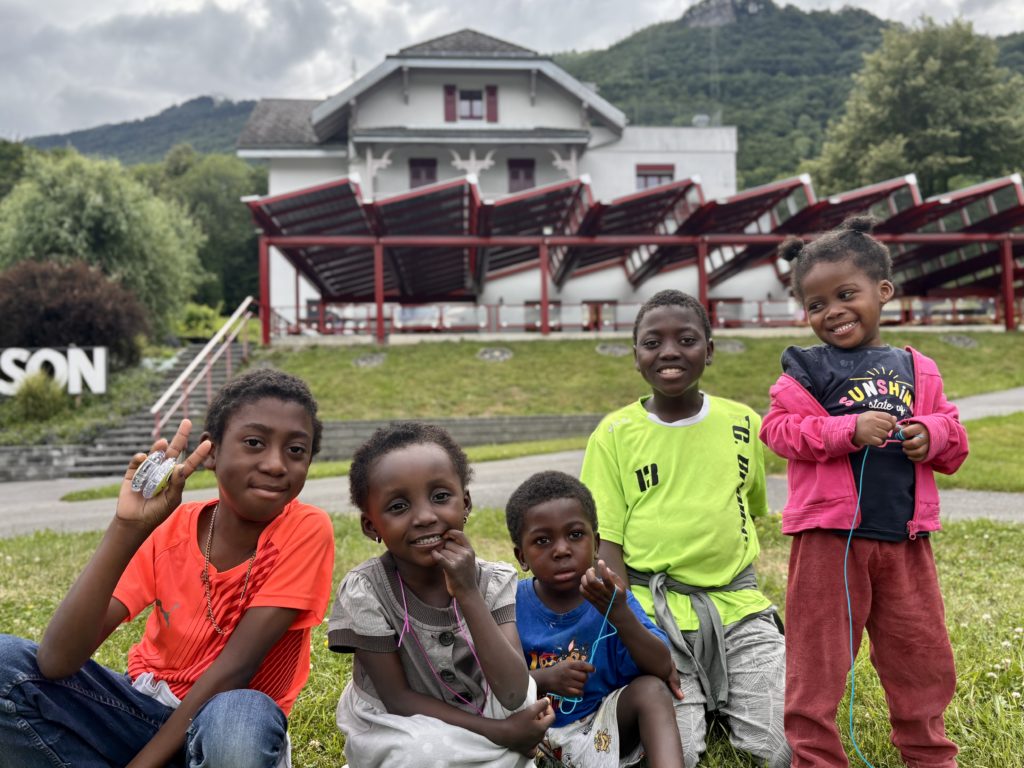A renovation for the benefit of children
written on the 29.09.2025A space for games, laughter and meetings, the terrace at La Maison is a vibrant place, filled with spontaneity and sharing. As soon as the nice weather arrives, the children gather there to have fun, breathe and enjoy a moment of lightness. Visitors, partners and friends passing through are welcomed with warmth and simplicity. Throughout the seasons, it also becomes the scene of events such as the “Rencontres Estivales“, which make the heart of the institution beat and strengthen connections. In 2024, its roof, marked by the years, underwent a complete renovation.
By Valérie Pellissier

Act with meaning, for today and tomorrow
At La Maison, every decision is based on a dual responsibility: to offer the children we support a protective and warm environment, while ensuring rigorous and responsible resource management.
The recent installation of solar panels on the terrace is perfectly in line with this approach. It significantly reduces our energy dependence, limits our environmental impact and, above all, to honour the trust of our donors. Every franc invested is done with transparency and awareness. This achievement reflects our commitment to long-term action, serving children and the world they will build tomorrow.
From Plexiglas to photovoltaics: a new momentum towards the future
When the terrace roof, installed in 1978, began to show signs of weakness, with worn Plexiglas panels and failing waterproofing, we decided not to settle for a purely functional repair. We thought more broadly by asking ourselves an essential question: how could we optimise our energy expenses, which represent a significant burden for the institution?
The project, launched in autumn 2024, was an obvious choice. Its ambition: to produce directly on-site part of the electricity needed for La Maison, taking advantage of the generous sunshine in our region.
Discreet and efficient technology
The 81 photovoltaic modules integrated into the new 250 m² roof blend naturally with the architecture of La Maison.
On the south side, the sloping panels capture the sun’s rays. On the north side, the glazed surface preserves natural light. The expected output is around 24’000 kWh per year, covering a significant part of our institution’s electricity needs.
But beyond the figures, it is the quality of the design that stands out: a custom-made aluminium structure, reinforced waterproofing and resistance to strong winds. Every detail has been carefully considered to ensure safety and reliability in a place that is very busy on a daily basis.
A useful, understated and meaningful project
By turning a technical constraint into an opportunity, La Maison has chosen a project that goes beyond simple refurbishment.
This achievement is part of a long-term vision, aligned with one of the values we uphold: a commitment to future generations.
This project was made possible thanks to the valuable support of the Loterie Romande, the Eagle Foundation Foundation and several local businesses, whom we warmly thank for their steadfast commitment to our cause and their generosity.
The secrets of eco-friendly cooking
For 26 years, Sébastien Lugon has worked with rigour and passion at La Maison to offer children healthy, balanced meals prepared with love. As head chef, he also contributes to the reputation of the “Rencontres Estivales”, an annual event open to the public, by treating guests to colourful and delicious dishes. Sébastien works closely with a team of dedicated chefs who share his commitment to quality cooking.

What do you think about the installation of solar panels at La Maison?
It’s a real bonus. Solar energy provides an ecological solution that fits well with our times and our values.
Do you think you can become energy independent in the kitchen?
Complete independence is not realistic, as our needs are significant and sometimes limited by schedules or the cooking of certain foods. But every kilowatt produced and used optimally is a benefit. We mainly see it as a way to reduce our consumption and adopt more responsible practices, both in the kitchen and in the laundry room, which is another major consumer of energy.
What habits have you put in place to limit waste?
One of the main things we do is measure portions more carefully. We serve slightly smaller plates, even if it means serving again if needed. And all food scraps are sorted and collected to be converted into biogas.
Are children made aware of these practices?
It’s not always easy because, in their countries of origin, sorting and recycling are often non-existent and their priorities lie elsewhere. But, in their own way, they realize that resources are not unlimited and that here, we take care not to waste them.
Do you work with local producers?
Yes, it’s a priority. We work with local producers and suppliers, especially for fruits and vegetables. We favour local, seasonal products whenever possible. Of course, some foods, like bananas that are very popular with children, come from elsewhere. But overall, we pay attention to the origin and production methods of the food we buy.
How do you manage to balance meal quality, budget and ecology?
We make sure we offer balanced meals, with meat or fish, a starchy food and a vegetable or a salad. We also vary the desserts, focusing on fruits. On the budget side, we closely monitor our suppliers’ promotions and take advantage of good deals. We also limit deliveries to once a week for most suppliers in order to reduce transportation. It’s a combination of efforts that, when added up, makes a difference.
Do you have any concrete examples of recent initiatives to reduce environmental impact?
We have reduced the use of disposable packaging and we prioritize durable tableware. We also reviewed our household products purchases to include more eco-friendly items. Finally, steps are being taken to strengthen our local partnerships. It’s a series of small improvements that matter.
Have you seen progress over the years?
Yes, definitely. We cook a lot more ourselves, which gives us better control over the quality of the meals and the origin of the products. We have professionalised the kitchen and implemented responsible practices in several areas: energy, waste and choice of suppliers.
In conclusion, what would you say about your environmental commitment?
There is always room for improvement, but we have already implemented many concrete actions. Waste sorting is well organised, we are mindful of transportation, and we strive to constantly improve our practices. The important thing is to move forward, step by step, with the desire to do the right things.
“Every kilowatt produced and used optimally is a benefit. We mainly see it as a way to reduce our consumption and adopt more responsible practices.”
Sébastien Lugon, Head Chef
